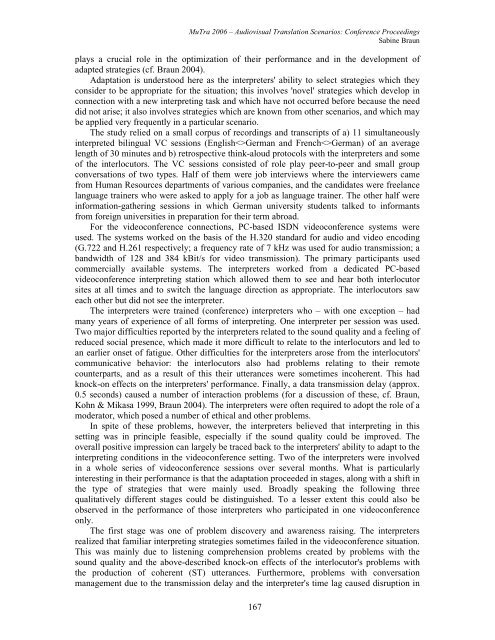Proceedings - Translation Concepts
Proceedings - Translation Concepts
Proceedings - Translation Concepts
You also want an ePaper? Increase the reach of your titles
YUMPU automatically turns print PDFs into web optimized ePapers that Google loves.
MuTra 2006 – Audiovisual <strong>Translation</strong> Scenarios: Conference <strong>Proceedings</strong><br />
Sabine Braun<br />
plays a crucial role in the optimization of their performance and in the development of<br />
adapted strategies (cf. Braun 2004).<br />
Adaptation is understood here as the interpreters' ability to select strategies which they<br />
consider to be appropriate for the situation; this involves 'novel' strategies which develop in<br />
connection with a new interpreting task and which have not occurred before because the need<br />
did not arise; it also involves strategies which are known from other scenarios, and which may<br />
be applied very frequently in a particular scenario.<br />
The study relied on a small corpus of recordings and transcripts of a) 11 simultaneously<br />
interpreted bilingual VC sessions (EnglishGerman and FrenchGerman) of an average<br />
length of 30 minutes and b) retrospective think-aloud protocols with the interpreters and some<br />
of the interlocutors. The VC sessions consisted of role play peer-to-peer and small group<br />
conversations of two types. Half of them were job interviews where the interviewers came<br />
from Human Resources departments of various companies, and the candidates were freelance<br />
language trainers who were asked to apply for a job as language trainer. The other half were<br />
information-gathering sessions in which German university students talked to informants<br />
from foreign universities in preparation for their term abroad.<br />
For the videoconference connections, PC-based ISDN videoconference systems were<br />
used. The systems worked on the basis of the H.320 standard for audio and video encoding<br />
(G.722 and H.261 respectively; a frequency rate of 7 kHz was used for audio transmission; a<br />
bandwidth of 128 and 384 kBit/s for video transmission). The primary participants used<br />
commercially available systems. The interpreters worked from a dedicated PC-based<br />
videoconference interpreting station which allowed them to see and hear both interlocutor<br />
sites at all times and to switch the language direction as appropriate. The interlocutors saw<br />
each other but did not see the interpreter.<br />
The interpreters were trained (conference) interpreters who – with one exception – had<br />
many years of experience of all forms of interpreting. One interpreter per session was used.<br />
Two major difficulties reported by the interpreters related to the sound quality and a feeling of<br />
reduced social presence, which made it more difficult to relate to the interlocutors and led to<br />
an earlier onset of fatigue. Other difficulties for the interpreters arose from the interlocutors'<br />
communicative behavior: the interlocutors also had problems relating to their remote<br />
counterparts, and as a result of this their utterances were sometimes incoherent. This had<br />
knock-on effects on the interpreters' performance. Finally, a data transmission delay (approx.<br />
0.5 seconds) caused a number of interaction problems (for a discussion of these, cf. Braun,<br />
Kohn & Mikasa 1999, Braun 2004). The interpreters were often required to adopt the role of a<br />
moderator, which posed a number of ethical and other problems.<br />
In spite of these problems, however, the interpreters believed that interpreting in this<br />
setting was in principle feasible, especially if the sound quality could be improved. The<br />
overall positive impression can largely be traced back to the interpreters' ability to adapt to the<br />
interpreting conditions in the videoconference setting. Two of the interpreters were involved<br />
in a whole series of videoconference sessions over several months. What is particularly<br />
interesting in their performance is that the adaptation proceeded in stages, along with a shift in<br />
the type of strategies that were mainly used. Broadly speaking the following three<br />
qualitatively different stages could be distinguished. To a lesser extent this could also be<br />
observed in the performance of those interpreters who participated in one videoconference<br />
only.<br />
The first stage was one of problem discovery and awareness raising. The interpreters<br />
realized that familiar interpreting strategies sometimes failed in the videoconference situation.<br />
This was mainly due to listening comprehension problems created by problems with the<br />
sound quality and the above-described knock-on effects of the interlocutor's problems with<br />
the production of coherent (ST) utterances. Furthermore, problems with conversation<br />
management due to the transmission delay and the interpreter's time lag caused disruption in<br />
167
















